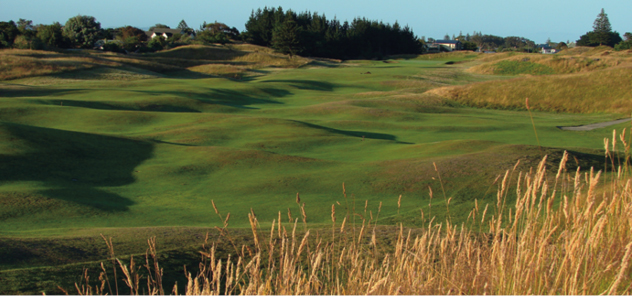 Fans of traditional links love playing at Paraparaumu Beach. American Tom Doak, long before returning to New Zealand to create Cape Kidnappers, listed Paraparaumu (pronounced Para-param) among his top 14 links layouts of the world, alongside the likes of the Old Course at St Andrews, Royal County Down and Ballybunion. This was high-class company for a course that began in the 1930s merely as an added attraction for real estate buyers looking for land in a new beachside village.
Fans of traditional links love playing at Paraparaumu Beach. American Tom Doak, long before returning to New Zealand to create Cape Kidnappers, listed Paraparaumu (pronounced Para-param) among his top 14 links layouts of the world, alongside the likes of the Old Course at St Andrews, Royal County Down and Ballybunion. This was high-class company for a course that began in the 1930s merely as an added attraction for real estate buyers looking for land in a new beachside village.
The original course was completely redesigned in 1949 by Dr Alister MacKenzie’s Australian associate Alex Russell, who had previously created Royal Melbourne’s East course and Lake Karrinyup in Perth. Paraparaumu crosses rugged, windswept dune lands, and despite the encroachment of the surrounding suburb – which the golf course helped establish – little has changed in nearly 60 years. Even so, it became apparent during the 2002 NZ Open – Tiger Woods’s first appearance in this country – that some of the old links character had been lost, purely because of the way the course was presented.
Changes to the course set-up and superior presentation in recent years have recaptured Paraparaumu’s original feel. Club manager and course superintendent Leo Barber is a keen student of the game. Under his guidance, the green surrounds have been closely shaved, putting a premium on accurate approach shots. These tight-cropped areas drop steeply off the edges of elevated greens, which now play firm and fast, just like the fairways. Several deep bunkers around the course have been revetted – modelled on the treacherous sod-faced bunkers of St Andrews. They are now formidable hazards.
The course can never be lengthened beyond its current distance because of the nearby housing. But that hasn’t stopped the club from trying occasionally. In preparing the layout for the 2002 Open, a new tee was built to add nearly 50 metres to the par-five closing hole; alas, all that did was straighten what had been a very good dogleg. The hole has since reverted to its shorter version, the way Russell designed it.
The 18th makes a wonderful climax to a string of world-class back nine holes. The 13th, a 408-metre par-four, is undoubtedly the best of them. Like the grand links courses of Scotland, four and five centuries old, there are humps and hollows – some of them huge – everywhere on your way to the green. A ridge that spans the fairway is the unique feature here, and if your drive is long enough to clear it you will be left with a short iron to a deep, narrow green.
The 126-metre, par-three 16th might be said to be the calm before the storm. It’s a little gem, reminiscent of the ‘Postage Stamp’ hole at Scotland’s Royal Troon, and similarly cut out the side of a small hill.
The storm arrives as you stand on the 17th tee and a decision needs to be made: do you take the left or right fairway? The fairway of this 404-metre par-four splits in two. You can shorten the hole by using the right fairway, but this leaves you with a trickier second shot to a green sitting diagonally to your approach. Driving to the left sets up a more straightforward but longer approach shot to a green that slopes away left, right and back.
|
MEMORABLE HOLES 2nd, 5th, 6th, 13th, 16th and 17th WHERE TO GO 376 Kapiti Rd, Paraparaumu Beach BOOK A ROUND (04) 902 8200, www.paraparaumubeachgolfclub.co.nz OTHER 120 GREAT COURSES NEARBY Royal Wellington (46 km), Cape Kidnappers (269 km) WHERE TO STAY Raumati Sands Resort, a few minutes’ drive from the course, offers luxury accommodation with coastal views. BEFORE/AFTER YOUR ROUND Mountains to the east of the golf course provide a scenic backdrop to your round. They are also home to Kapiti Four x 4 Adventure, who run off-road quad bike tours through the native wilderness of the stunning Akatarawa Ranges. |
